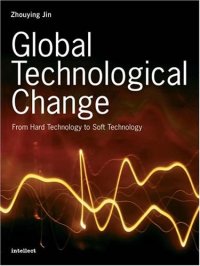
Ebook: Global Technological Change: From Hard Technology To Soft Technology
Author: Zhouying Jin
- Genre: Economy
- Year: 2005
- Publisher: Intellect (UK)
- Edition: illustrated edition
- Language: English
- pdf
I had the opportunity to meet briefly with Professor Jin while vacationing in Beijing and subsequently read her book on "Global Technological Change: From Hard Technology to Soft Technology". Without reservation, this work is highly recommended to anyone working with the human side of technology development and use. In fact, I'm inclined to say that Professor Jin's work is a breakthrough and fills a significant gap that exists in the new global economy. We need a comprehensive theory, set of principles, terminology, framework and model that describes how we create and use technology. More focus needs to be clearly on the "we" or the human dimension.
During the last two or three decades there have been a series of efforts to bring attention to the human dimension of work as it relates to technology advancements. For example, Calvin Pava's work at Harvard with socio-technical analysis provided this perspective for the environment of the knowledge worker. There have also been continuous developments in the discipline of human factors; however, human factors addresses only a specific set of domains and issues. We do need a more generic comprehensive approach. As Professor Jin puts it, we need an approach that addresses "skills, tools and rules that are employed by humans to alter, accommodate and manage nature for human survival and development." To that end, she defines soft technology as the intellectual technology of creation and innovation centered in human thought, ideology, emotion, values, world view, individual and organizational behaviors, as well as in human society."
Professor Jin presents a solid foundation for espousing her work on soft technology. This includes frameworks that have philosophical roots in Chinese culture. I find her use of the harmony and balance dynamics from eastern "yin-yang" philosophy to be extremely useful in the relationship between hard technology and soft technology. This analogy is easily communicated and the resulting framework has enough breadth to expand and structure our views about how we should consider soft technology in the creation of hard technology.
This book is also a must read for people who are doing business in China, especially those involved in research and development. Numerous Chinese examples are provided that relate to the academic basis of soft technology as well as to Chinese business, cultural, and political considerations. Researchers will find the bibliography to be a substantial source for Chinese publications in related disciplines. I would recommend that future editions of the book provide an index for reader convenience. In the effort to accomplish the challenging work of translation, the index may have been overlooked.
During the last two or three decades there have been a series of efforts to bring attention to the human dimension of work as it relates to technology advancements. For example, Calvin Pava's work at Harvard with socio-technical analysis provided this perspective for the environment of the knowledge worker. There have also been continuous developments in the discipline of human factors; however, human factors addresses only a specific set of domains and issues. We do need a more generic comprehensive approach. As Professor Jin puts it, we need an approach that addresses "skills, tools and rules that are employed by humans to alter, accommodate and manage nature for human survival and development." To that end, she defines soft technology as the intellectual technology of creation and innovation centered in human thought, ideology, emotion, values, world view, individual and organizational behaviors, as well as in human society."
Professor Jin presents a solid foundation for espousing her work on soft technology. This includes frameworks that have philosophical roots in Chinese culture. I find her use of the harmony and balance dynamics from eastern "yin-yang" philosophy to be extremely useful in the relationship between hard technology and soft technology. This analogy is easily communicated and the resulting framework has enough breadth to expand and structure our views about how we should consider soft technology in the creation of hard technology.
This book is also a must read for people who are doing business in China, especially those involved in research and development. Numerous Chinese examples are provided that relate to the academic basis of soft technology as well as to Chinese business, cultural, and political considerations. Researchers will find the bibliography to be a substantial source for Chinese publications in related disciplines. I would recommend that future editions of the book provide an index for reader convenience. In the effort to accomplish the challenging work of translation, the index may have been overlooked.
Download the book Global Technological Change: From Hard Technology To Soft Technology for free or read online
Continue reading on any device:

Last viewed books
Related books
{related-news}
Comments (0)